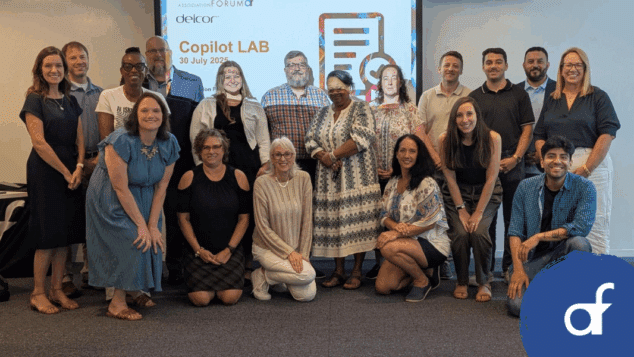To Gate or Not to Gate

It’s difficult to imagine there’s anyone in the marketing world who hasn’t been involved in a “to gate or not to gate” debate. What content should we share, how do we share it, and how can we protect it? Some marketers stand firmly in the “free” camp, touting the benefits of brand awareness, SEO, shares and engagement. Others, usually more traditional marketers, believe opening the floodgates gives away valuable lead generation data — the equivalent of gold in today’s online currency model.
For associations, whose business is content, research and membership, it’s a constant conundrum. What should we protect? What do our members need? How can we be thought leaders and build our online brand but also capture prospects and leads?
A Quick Refresher
Gated content requires an information exchange in order for someone to access, read, view or share your content. The purpose is that requiring information will generate leads for your association. You can then use those leads for marketing, membership solicitation, and engagement.
Ungated content doesn’t require the sharing of any personal information. Everything is wide open, completely free. While there may be a side gate — a chance to ask users to voluntarily sign up for more content — it doesn’t stop them from devouring whatever content they’re craving. Plus, SEO crawlers can find everything — putting you at the top of the search engine results. (See Back to Basics)
Which is better? Not surprisingly, there is no right answer and the path forward is riddled with nuances, organizational conversations, a focus on goals and objectives, and sometimes just a gut feeling.
To gain insight into these back-and-forth discussions, FORUM spoke with three marketers — Mimi Collins, director of content strategy for the National Association of Colleges and Employers; Cam Brown, CEO of King Fish Media; and Paul Bergeron, executive editor of Thought Leadership Today.
FORUM: Help us establish a baseline. In your opinion, what are the pros and cons of gated content?
Brown: Before we think about the pros and cons of gated content, it’s critical to put some boundaries around what constitutes content. The tent that used to be the domain of journalists and subject matter experts has lifted the flaps to include social media and the brands that use it. Tweets, blogs, Facebook and YouTube channels, and influencers on Instagram are flooding their version of content into an industry whose traditional channels are contracting — fast. And in light of this colossal flood of content, an opportunity presents itself. For associations, elevating the quality of your content allows you to quickly stand-out from the junk flooding the market.
Once you’ve presented your association as thoughtful — and have built confidence in your readers that you are not shilling for a product or service, but rather presenting helpful information — you face that ultimate choice to gate or not to gate. If you gate it, you are attaching a premium to the quality and requesting something in return: an email address, phone number or monthly subscription. Each is a reasonable requirement for high-value information that offers some form of competitive advantage to the reader. However, the last half a decade has nurtured a mistaken behavior that equates content with free. Regardless of the quality, there is an expectation that everything online should be free.
Ultimately, I would suggest that successful associations offer both: share with prospective members the benefits they will receive through partnership with your brand. Allow a preview of the good stuff that is only for customers and members, and let them understand the value proposition your association is offering them in exchange for subscribing, paying and sharing an email.
Bergeron: Providing consistently valuable, timely content is the key to driving membership and revenue growth for an association. Publishing, promoting and sharing this information builds an association’s overall reputation and generates greater interest and credibility in what it has to offer top to bottom.
Industry members who do belong to your association will visit your resources often and will be inclined to share that info with others, including those who aren’t members. This is a chance for you to successfully recruit those members. But if links to important information are behind a paywall — or protected in some way — then these prospects won’t be able to see it or its value.
Sure, saying, ‘You have to join to see it’ is one response. But that can leave the prospect feeling flat and less interested.
Associations should be confident that there is value in their association from top to bottom. You have to get them through the door (your website) so they can ‘look around’ and see what resources are available. After that, if the content is good, they may sign up for webinars, attend your conference or participate in some other revenue-generating ways.
Ideally, each “free” news or informational post will soft-sell a related channel to learn more about a given topic, typically involving cost. Examples would be a live or recorded learning event, white paper or podcast.
One form of content that can blend free and cost is significant research products. If an association commissions a national report — one that is also segmented based on geographic markets — it should issue a national executive summary and share it for free, using that to tease out the localized data that is for sale.
Collins: There’s no perfect formula and you’re not going to get everything you want either way. You always have to weigh what the benefits are and where the problems are. For example, at our association, SEO is a big consideration. If anything is behind a gate, the SEO crawlers can’t get to it. The debate of gated versus free is something that we revisit on a regular basis. It’s really more about whether things should be password protected for members versus the public.
But the bottom line is you can’t look at gated or free content in isolation. These conversations have to be part of a larger, more holistic content strategy. And they also relate directly to how we are perceived — and want to be perceived — as an association thought leader.
- generates more inbound links through SEO
- builds brand awareness
- promotes social engagement and shares
- allows for higher page rankings from well-written, thought leadership content
Gated Content
- increases inbound leads
- allows for the capture of information
- increases prospect leads
Forum: Are there special considerations for associations as compared to other types of businesses?
Bergeron: Associations should work to have some of their most valuable content pieces be sponsored by its leading supplier members. This way, it’s “free” to members and the association can earn some revenue. The key here, though, is to make sure that the suppliers don’t hijack the look and feel of the content — maintain the editorial staff’s independent direction — or members and prospects will feel that they are being sold to. If the content is solid, the suppliers will appreciate having their name or logo next to it.
In my opinion, content that should be kept behind a wall would be that related to policy positions, to some degree. For example, if your association is lobbying for certain points of view or has commentary that is best left for its executive staff, lobbyists and government officials to discuss and debate.
Collins: Associations and businesses have some things in common: What does your customer want and what does your customer value? A lot of businesses use content marketing as a strategy for swooping in and making a sales pitch. And that’s great. But associations don’t typically have that. Our goal is to increase membership — there’s no product demo for that.
There are a number of marketing consultants out there who would say everything should be open and accessible. From their point of view, I understand that. But it doesn’t work realistically, especially for associations. For associations, if you give everything away, what’s the value of membership? And why would people be members? So that’s really the heart of everything.
Forum: This debate isn’t going away. What other words of wisdom can you pass along?
Bergeron: Craft every piece of content marketing and website post with a “WIIFM” approach: What’s In It For Me? This is why your members are reaching out to you in the first place. Sadly, if you click on a dozen or so association websites at random, chances are, the home pages of most will be dominated by the association talking about itself, and it becomes a billboard with pitches about how its members can spend money by registering for events or purchasing information. People generally do not like to be sold to. By creating a website that gives visitors the chance to search and discover the information they need, they will recognize the worth in association membership and will want to join and participate with you. The subsequent engagement will take care of itself.
Base your content on real-life, member-based storytelling. Sure, lean on your association’s experienced and knowledgeable veteran staff members to write about or to interpret critical topics that affect your industry. These voices of authority are helpful.
But it’s much better to tackle these subjects by sharing detailed storytelling from your membership: Those who are on the ground dealing with topics such as regulations, innovative technologies or discovering greater efficiency in their operations.
Collins: Remember that you cannot make these decisions in isolation. You need to get input and buy-in from all the players in your organization. For example, I need buy-in from my executive director, marketing director, membership staff, the director of research, assistant executive director — all of those folks need to have some input because if you’re looking at how these relate to your strategic goals, then everybody needs to be involved in those conversations. And document things so you can go back and look, measure and compare what you’re doing with what you said you wanted to achieve.
Brown: Invest in quality content, and reap the benefits with a more committed audience that understands value over volume. You achieve this relationship by investing in content created by journalists and subject matter experts who are best positioned to inform your audience and ignore simple brand promotion. Your readers are smart — treat them to what they deserve.
Planning and documenting your content goals and objectives will help during “to gate or not to gate” debates. Write these questions down. Have stakeholders weigh in. Refer back to the answers frequently. Revise as necessary.
- What is this content supposed to do? [Possible goals: brand awareness, blog visits, B2B lead generation, converted users]
- How will this piece of content achieve those goals?
- How much are your goals worth to you?
- Does gating this piece of content fit into my larger content goals?
- Does this content directly impact your lead gen efforts?
- Can you move the content from behind a gate or change strategy and still acquire leads?
Source: TechnologyAdvice.com
Tags
Related Articles
The Power of Taking the AI Journey Together
Forum’s first Microsoft Copilot Lab brought together 20 professionals to explore how smart adoption of...
Protecting Healthcare: Tackling Cyber Threats to Hospitals and Patients
The critical role of cybersecurity in healthcare and association management.
How to Use ChatGPT in Association Work
ChatGPT can be another tool for work efficiency, but there are precautions to take as...




